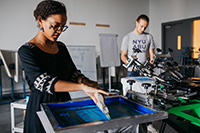-
Academics
-
Admissions
 Your journey to NYUAD starts here. Attend an application workshop or information session.Admissions Events
Your journey to NYUAD starts here. Attend an application workshop or information session.Admissions Events -
Research
-
Campus Life
 Live the possibilities. Be part of a dynamic community of students from over 115 countries.Take a Tour
Live the possibilities. Be part of a dynamic community of students from over 115 countries.Take a Tour - Public Programs
-
About
Exceptional education. World class research. Community-driven.Our Story
- News
- Events
- Social Media Directory
- Press Room
-
- Torch at NYUAD
- Faculty
- Current Students
- Alumni
- عربي
Design and Fabrication of Multifunctional 3D Printed Structures for Water Treatment
Membrane fouling remains one of the main challenges in the membrane separation processes since it deteriorates the membrane performance and shortens its lifespan. In this regard, 3D printing technology offers an innovative way to minimize membrane fouling as it allows great control over the material composition and the object geometry. In the spiral wound membrane modules (SWM), feed spacers play a major role in supporting the membranes and promoting enough turbulence to enhance the mass transfer rates and decrease membrane fouling.
At the NYUAD WRC, we are developing advanced material formulations that can be used to 3D-print feed spacers with multifunctional capabilities and various geometries. The use of graphite and nanostructured silver to fabricate electrically conductive interdigitated spacers offers in-situ membrane cleaning via periodic electrolysis. Similarly, 3D printing of feed spacers directly onto the membrane surface offer improved fouling resistance and enhanced output flux. Our current research activities focus on integrating feed spacers onto membrane surfaces with strong mechanical adhesion as well as durability without significantly affecting the overall cost. Recently, our research demonstrated the potential of 3D printing of zeolites for the removal of toxic heavy metal ions from wastewater in a column-type configuration. This research opens new doors for the industry to apply low-cost materials more efficiently in water treatment applications.
